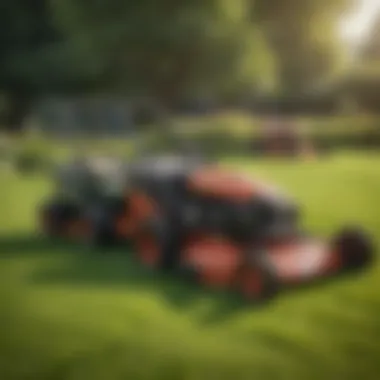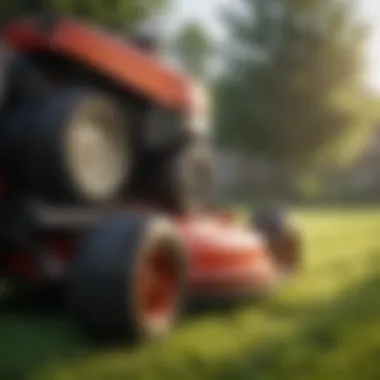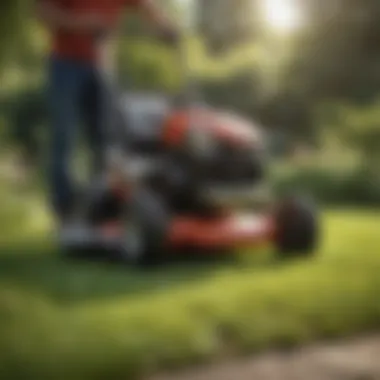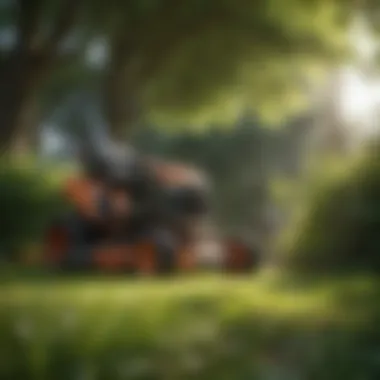Comprehensive Guide to Walk Behind Lawn Mowers


Key Concepts and Terminology
Basic Definitions
Walk behind lawn mowers are machines designed for residential and commercial lawn care. They are pushed or pulled by the operator, requiring human effort to maneuver. These mowers can be categorized into several types, including reel, rotary, electric, and gas-powered models. Understanding these distinctions is crucial to making informed decisions based on your specific needs.
A reel mower features rotating blades positioned in a cylinder, providing a precise cut, ideal for smaller yards. Rotary mowers, on the other hand, utilize a horizontally spinning blade, suitable for diverse grass types and larger areas. Electric and gas-powered options present their own advantages and disadvantages, primarily revolving around power sources and operational costs.
Historical Context
The evolution of lawn mowers traces back to the 19th century. The first mechanical mower was invented by Edwin Beard Budding in 1830, designed primarily for cutting grass in sports fields. Over the decades, technology advanced significantly, leading to the electric and gas-powered machines we use today. Each innovation aimed to improve efficiency and user convenience, with increased focus on sustainability in recent years.
Recent Innovations and Trends
Technological Advancements
Today’s walk behind lawn mowers are equipped with several modern features that enhance performance. Self-propulsion is one significant advancement, allowing users to control speed without excessive exertion. Benefits of this technology include reduced fatigue and improved maneuverability, especially on uneven terrain. Moreover, mowers now often have adjustable cutting heights and enhanced blade designs to cater to varying grass types.
Sustainable Practices
As environmental awareness grows, more manufacturers are focusing on sustainability within their mower designs. Electric models are becoming increasingly popular due to their reduced carbon footprint and lower noise levels compared to gas-powered alternatives. Additionally, many models incorporate recyclable materials and offer features like grass mulching and bagging systems that minimize waste.
Practical Applications and Techniques
Step-by-step Guides
When selecting the right walk behind mower, consider these steps:
- Assess your yard size and type of grass.
- Determine the power source – electric or gas.
- Decide on preferred features, such as self-propulsion and cutting width.
- Review budgetary constraints and product reviews.
Case Studies
Exploring real-life usage can provide valuable insights into mower performance. For instance, a local horticulturalist adopted an electric rotary mower for her urban garden. She reported significant improvements in efficiency and noise reduction compared to her previous gas mower. This transition not only enhanced her gardening experience but also contributed positively to her community’s environmental goals.
Modern walk behind mowers are not merely tools; they serve as integral components of sustainable gardening practices.
In summary, understanding the key concepts and terminology surrounding walk behind lawn mowers assists users in making educated choices. Innovations in technology and sustainable practices emphasize the importance of these machines in contemporary lawn care.
Intro to Walk Behind Lawn Mowers
Walk behind lawn mowers are an essential tool for maintaining tidy and healthy lawns. They provide users with the ability to easily manage grass height while ensuring the efficiency of the mowing process. The increasing interest in residential gardening and landscaping highlights their relevance. Being able to choose the right mower can significantly affect not just the appearance of the yard but also the overall health of the grass.
The consideration of size, engine type, and ease of use are all critical factors when assessing walk behind mowers. As homeowners prioritize landscape aesthetics, the demand for high-quality mowers continues to grow. Understanding how these machines operate, their capabilities, and the specific needs of different homeowners contributes to better decision-making.
Some of the benefits of using a walk behind mower include:
- Improved Control: Walk behind mowers offer users greater control over the cutting process compared to riding mowers.
- Cost Efficiency: Generally, they are more affordable than other types of lawn mowers, making them accessible for many homeowners.
- Environmental Impact: Many mowers are designed to be eco-friendly, using less fuel or electricity than larger models.
Important considerations include the type of terrain, mower weight, and the operator's physical ability. A detailed evaluation of these factors assists in selecting the best mower for individual needs.
"The right walk behind mower can transform lawn care from a chore into an enjoyable activity, enhancing your gardening experience."
In summary, this section emphasizes the critical role of walk behind lawn mowers in lawn maintenance. Their strategic advantages and the importance of informed selection underpin the comprehensive nature of this guide.
Types of Walk Behind Lawn Mowers
Understanding the different types of walk behind lawn mowers is essential for any home gardener or landscaping professional. Each type serves distinct purposes and presents unique advantages. This section explores the primary categories of lawn mowers: reel mowers, rotary mowers, self-propelled mowers, and push mowers. Recognizing these differences will help users choose the right mower according to their specific needs and lawn conditions.
Reel Mowers
Reel mowers are the oldest type of grass-cutting machinery. They operate through a set of spinning blades that cut grass just like scissors would. These mowers are best for small, flat lawns where quick mowing is not a priority.
Benefits of Reel Mowers:
- Eco-Friendly: No gas or electricity needed, making them sustainable.
- Quiet Operation: Allows you to mow without disturbing neighbors or wildlife.
- Healthy Grass: The clean cut promotes healthier grass growth.
Considerations:
Reel mowers require a certain mowing technique to be effective. Users must walk at a consistent pace to avoid missing grass patches. Furthermore, these mowers may struggle with longer or thicker grasses, making them less suitable for larger or more unkempt lawns.
Rotary Mowers
Rotary mowers are the most common type found in homes today. They feature a single blade that spins horizontally beneath the mower deck. This design enables them to handle taller and thicker grass effectively, which makes them versatile in various yard conditions.
Benefits of Rotary Mowers:
- Powerful Cutting: Suitable for various grass types and lengths.
- Adjustability: Most models come with adjustable height settings for cutting.
- Availability: Widely available, with many brands and models to choose from.
Considerations:
The engine type, whether electric or gasoline, affects maintenance and fuel costs. Gasoline rotary mowers, while powerful, tend to produce more emissions than their electric counterparts. Users should think about their mowing frequency and lawn size when selecting this type of mower.
Self-Propelled Mowers
Self-propelled mowers offer a significant advantage in terms of ease and comfort. They feature a transmission system that provides power to the wheels, allowing the mower to move forward without needing much physical effort from the user.
Benefits of Self-Propelled Mowers:


- Less Physical Strain: Ideal for larger lawns where manual pushing can be taxing.
- Speed Control: Many models allow the user to set their preferred speed.
- Efficient Cutting: Can navigate varying terrains more effectively than push mowers.
Considerations:
Despite the convenience, self-propelled mowers are generally heavier and may require more maintenance. The purchase price can also be higher compared to push or reel mowers.
Push Mowers
Push mowers are straightforward machines that require the user to manually push them across the lawn. This type is typically less complex and more affordable, making it a popular choice for small yards.
Benefits of Push Mowers:
- Affordability: Generally less expensive than other types.
- Simplicity: Easy to operate and maintain, with fewer mechanical parts that may fail.
- Control: Offers precise cutting since the user actively manages the mowing speed and direction.
Considerations:
Push mowers can be tiring to operate over larger areas and may be less effective on uneven terrain. Users who regularly mow a large yard might find them inefficient over time.
In summary, choosing the appropriate type of walk behind lawn mower depends heavily on individual yard conditions and personal preferences. Each type brings its unique advantages and is more suitable for specific tasks.
Key Features of Walk Behind Lawn Mowers
Understanding the key features of walk behind lawn mowers is critical for making informed decisions. Each feature not only impacts the performance of the mower but also influences the end-user experience. Knowing these aspects helps the buyer select a mower that caters specifically to their needs, ensuring optimal efficiency and satisfaction.
Cutting Width
The cutting width of a mower represents the swath of grass it can cut in a single pass. This feature is vital for efficiency. A wider cutting width can reduce mowing time on larger lawns, as fewer passes are needed to cover the area. However, smaller cutting widths might be advantageous in tight spaces or intricate landscaping. For example, a cutting width of 20 inches may suit a small yard with multiple flower beds, while a 30-inch width could be more suitable for an expansive lawn.
When evaluating cutting width, also consider the type of grass being cut. Different grasses may need specific cutting widths for a healthy cut. A user's subjective experience can also influence the choice, as some may prefer the control and precision of smaller cutting widths.
Engine Power
Engine power is the heart of any lawn mower, directly affecting performance. Measured in horsepower, a mower's engine power determines its ability to handle various terrains and grass types. Mowers with more horsepower are generally better equipped to handle dense turf, tall grass, or uneven surfaces.
Moreover, engine power correlates with speed. A mower with sufficient power can operate faster and more effectively, crucial for impressively large yards. However, potential buyers must align engine specifications with their mowing habits and needs.
Weight and Maneuverability
The weight of a lawn mower impacts maneuverability and ease of use. Heavier mowers may deliver a cleaner cut but could be cumbersome, especially on hilly terrain or in confined spaces. Conversely, lighter mowers can be easier to handle but may sacrifice cutting efficiency, especially on thicker grasses.
A good balance between weight and maneuverability should be achieved. Consider the size of the lawn and the mower's intended use. Professionals or avid gardeners working on expansive properties might prioritize a powerful, heavier model. Meanwhile, homeowners with smaller properties might favor lighter, easier to handle mowers. This consideration ultimately enhances the overall mowing experience.
Handling Systems
The handling system has a substantial impact on user comfort and control. Different mowers come with various types of handling systems that enhance maneuverability. A self-propelled mower offers ease of use, particularly for large or hilly lawns, as the mower moves forward without requiring significant effort from the user. In contrast, push mowers demand more physical exertion, making them better suited for smaller, flat lawns.
Additionally, features like adjustable handles can significantly improve comfort. Users can work for longer periods without fatigue. Furthermore, a well-designed handling system promotes precision in cutting, especially around obstacles. Choosing the right handling system can make mowing less laborious and more enjoyable.
Selecting a mower with suitable key features is essential for efficiency and comfort, impacting overall lawn care quality.
These elements—cutting width, engine power, weight, and handling systems—are essential considerations in selecting the right walk behind mower. By carefully examining these features, one can ensure that their choice meets their mowing needs effectively.
Selecting the Right Walk Behind Lawn Mower
Choosing the right walk behind lawn mower is crucial for achieving a well-maintained lawn. Various factors influence this decision, ranging from the size of your yard to the specific type of grass you have. Selecting the appropriate mower ensures efficiency and effectiveness, making the mowing process less of a chore and more of a manageable task. The right choice can also enhance your lawn’s health by delivering optimal cutting performance.
Assessing Yard Size and Terrain
The size and layout of your yard significantly affect the type of mower you should consider. A small flat yard may not require the power of a self-propelled mower, whereas larger areas or those with uneven surfaces may benefit from the improved maneuverability and power of a self-propelled model.
- Flat Terrain: If your yard is mostly flat, a push mower or a reel mower could suffice. These options often weigh less, making them easier to handle.
- Hilly or Uneven Terrain: For those with slopes or rough patches, self-propelled mowers become essential. They assist in reducing the physical effort required to mow while maintaining control on slopes.
- Obstacles: Evaluating your yard's layout is also important. Features like flower beds, trees, or pathways can determine the size and type of mower needed. A mower with a smaller cutting width may navigate better around tight areas.
Understanding your yard's dimensions and challenges allows you to choose a mower that fits seamlessly into your mowing routine.
Determining Cutting Preferences
Cutting preferences play a role in selecting a mower that meets your expectations for grass length and quality. This aspect includes several considerations:
- Cutting Height Adjustment: Some mowers offer the ability to adjust cutting height easily. This is beneficial if you prefer a specific grass length or require varying lengths during different seasons.
- Grass Type Consideration: Your lawn's grass type should inform your choice as well. For example, fine grasses may require different cutting techniques than robust varieties. The capability to set different heights for various grass types is crucial for optimal health.
- Clumping and Discharge: Consider how you would like the grass clippings to be treated. Some mowers provide options for bagging clippings, mulching them, or side discharging. Each method has its merits; bagging keeps the lawn tidy while mulching can return nutrients to the soil.
- Frequency of Mowing: If you mow frequently, a mower with a wider cutting deck may reduce the number of passes needed, increasing efficiency. Conversely, if you mow less often, narrower decks may suffice, but this could lead to longer mowing times.
Thus, aligning the mower with your cutting preferences and practices ensures a rewarding mowing experience, while also supporting lawn health.
Eco-Friendly Considerations
The modern shift towards sustainability extends to lawn care, making eco-friendly considerations critical for consumers choosing walk behind lawn mowers. This section investigates the environmental impact of these machines and evaluates the eco-friendliness of different models, focusing on their energy sources, noise levels, and overall contribution to ecological balance.
Electric vs. Gasoline Models
Electric lawn mowers have gained popularity due to their lower environmental footprint. They produce zero exhaust emissions, which significantly reduces air pollution. Moreover, many electric models utilize rechargeable batteries, eliminating the need for fossil fuel. Brands such as Ego Power+ and Greenworks offer models that can handle regular mowing tasks effectively.
On the other hand, gasoline mowers, while powerful and capable of handling larger areas, emit harmful pollutants and contribute to greenhouse gases. However, some may argue that gasoline mowers provide a greater range and power for extensive tasks. A few examples of known gasoline models include Honda HRX and Troy-Bilt TB290.
When considering the choice, it is essential to reflect on the yard size and specific mowing needs. Electric mowers may not be ideal for larger spaces unless sufficient battery power is available.
Noise Pollution Impact
Noise pollution is an often-overlooked factor in lawn maintenance. Traditional gasoline mowers typically operate at higher decibel levels compared to their electric counterparts. This not only disturbs the tranquility of residential neighborhoods but can also have adverse effects on local wildlife. Many electric models, including those from Ryobi and Snapper, operate much quieter, making them a preferable option for energy-conscious homeowners.
The impact of noise pollution includes the potential for stress and disruption among neighbors and household members. Therefore, utilizing quieter machines, such as electric mowers, can enhance the mowing experience while being considerate of those around you.


"Choosing the right lawn mower model can dramatically influence your environmental footprint and community noise levels."
Maintenance of Walk Behind Lawn Mowers
Maintaining walk behind lawn mowers is crucial for ensuring their longevity and optimal performance. Regular maintenance is not just a recommendation; it is essential for achieving a well-manicured lawn and extending the mower's lifespan. Neglecting maintenance can lead to decreased efficiency, poor cutting quality, and potentially costly repairs. This section will explore the specific elements of maintenance, reasons why it is important, and the considerations to keep in mind for different types of mowers.
Routine Checks and Balancing
Routine checks should be an owner’s priority to keep walk behind mowers in good condition. These checks typically involve examining the engine oil, air filter, spark plug, and belts. Ensuring sufficient engine oil is vital as it lubricates moving parts, reducing friction and wear. Checking the air filter is equally important. A clean air filter improves airflow and engine efficiency.
It’s advisable to inspect the spark plug for wear and dirt, replacing it as necessary. Moreover, keeping an eye on the mower's belts will help avoid issues that could arise from fraying or misalignment.
Balancing the mower can enhance cutting performance. An unbalanced mower may provide uneven cuts, and may even cause damage to the lawn. Regular balancing ensures the deck and blades interact correctly, promoting more efficient mowing.
Sharpening the Blades
Sharpening the blades of a walk behind mower is critical. Dull blades tear grass instead of cutting it cleanly, causing stress and potential disease to the grass. It is recommended to sharpen the blades at least once during the mowing season, or more often if you mow frequently or encounter tough grass. The sharpening process typically involves removing the blades, using a file or grinder to sharpen the edges, and then reattaching them securely.
Ensuring the blades are sharp not only benefits the grass but also maintains the mower's efficiency. It requires less power to operate sharp blades. Thus, regular sharpening can lead to fuel savings.
Seasonal Cleanup Procedures
Seasonal cleanup is an essential step in maintaining walk behind lawn mowers. At the end of each mowing season, thorough cleaning is necessary. This involves removing all grass clippings, dirt, and debris from the mower deck. This detritus can lead to rust and corrosion, ultimately reducing the mower's lifespan.
Additionally, seasonal cleanup should also include inspecting the wheels and undercarriage for any signs of wear or damage. Proper maintenance in the off-season can prevent potential issues when the next mowing season begins. Moreover, storing the mower properly in a dry location is vital to protect it from weather-related damage.
Troubleshooting Common Issues
In the realm of walk behind lawn mowers, troubleshooting common issues is a vital area that ensures these machines run effectively. The significance lies in understanding potential problems, allowing enthusiasts and professionals alike to resolve them before they escalate. A well-maintained mower enhances performance and prolongs its lifespan, making troubleshooting not just about fixing problems, but also about promoting efficiency and durability.
Poor Cutting Performance
One of the first signs that something is amiss with a walk behind lawn mower is poor cutting performance. This issue can manifest itself as uneven grass cutting or even the mower leaving patches of grass untrimmed. Several factors can contribute to this problem, and identifying these is crucial for effective resolution.
- Dull Blades: Sharp blades are essential for clean cuts. Over time, blades can become dulled and will need sharpening. A quick check on the sharpness can save frustration as blades that are not cutting well can lead to a ragged appearance on the lawn.
- Incorrect Cutting Height: Adjusting the cutting height based on grass type and growing conditions is important. If the mower is set too low, it may scalp the lawn, while a setting too high will leave grass uncut.
- Clogged Deck: Grass build-up can clog the mower deck. After several uses, it is advisable to check for clogs and clean the underside to avoid such issues.
- Engine Power Issues: Any problems with the engine may result in decreased power. Checking fuel levels and ensuring that the air filter is clean can often resolve performance dips.
By addressing these factors promptly, operators can restore their mower's cutting efficiency, which directly affects the health and appearance of their lawn.
Engine Starting Problems
Engine starting problems can be a significant frustration for users of walk behind lawn mowers. Understanding why an engine won't start involves examining several key components that could be at fault.
- Fuel Issues: Old or contaminated fuel can prevent the engine from starting. It’s important to use fresh fuel and store gasoline properly to avoid degradation.
- Spark Plug Condition: A faulty or dirty spark plug can inhibit the ignition process. Regularly checking the spark plug and replacing it if necessary can ensure reliable starts.
- Battery Charge: For mowers with electric starts, a dead battery is often the culprit. Ensuring that the battery is charged and connections are clean can easily fix this issue.
- Starter Mechanism: If other components appear fine, the starter mechanism itself may be faulty. Detecting wear or damage in this area will be crucial for repair.
"Regular maintenance and prompt troubleshooting can keep your mower running smoothly and ensure an attractive lawn throughout the growing season."
Incorporating these practices and insights will empower lawn care enthusiasts to manage their machines effectively.
Innovations in Lawn Mower Technology
In recent years, the lawn care industry has witnessed significant advancements in technology, particularly in the realm of walk behind lawn mowers. These innovations not only enhance performance but also contribute to a more sustainable approach to gardening. Understanding these technological improvements is crucial for both agricultural professionals and gardening enthusiasts, as they offer numerous benefits that can ultimately ease maintenance efforts and optimize the mowing experience.
Automated Mowing Systems
Automated mowing systems have revolutionized how land is maintained. These systems, often referred to as robotic mowers, can navigate yards independently, relying on sophisticated built-in sensors and algorithms. Users can set up specific boundaries, allowing these mowers to operate without human intervention.
Some key advantages of automated mowing systems include:
- Time-saving: Homeowners can allocate time to other tasks, as these mowers take care of grass cutting while they focus on other projects.
- Consistency: These devices maintain a regular mowing schedule, ensuring an even and healthy lawn.
- Efficiency: The robotic systems use energy efficiently, which may lead to lower utility bills over time.
However, there are considerations to keep in mind when choosing automated mowing systems. For instance, they may not be suitable for all yard types, particularly those with steep slopes or densely packed landscaping. Understanding specific yard needs is critical for selecting the right system.
Smart Features and Connectivity
Another facet of innovation in lawn mower technology lies in the integration of smart features and connectivity options. Modern walk behind lawn mowers now often come equipped with mobile app integration, Bluetooth connectivity, and even artificial intelligence capabilities. These enhancements can drastically improve user experiences and mower performance.
Some notable smart features include:
- Remote Control: Users can manage operations from a smartphone, allowing for adjustments without needing to physically be present.
- Real-time Monitoring: These mowers can provide updates on their status, including battery level, cutting progress, and error notifications.
- Data Analytics: By collecting usage data, smart mowers can help users optimize their mowing habits, leading to improved grass health and resource management.
With the integration of technology, walk behind lawn mowers are transforming traditional mowing into a more engaging and efficient task. The combination of automated systems and connectivity opens up new possibilities within lawn care.
"Innovations in lawn mower technology mark a significant shift towards effortless garden maintenance and resource efficiency."
Best Practices for Efficient Mowing
Efficient mowing is crucial for maintaining a healthy and attractive lawn. By following best practices, homeowners can ensure their grass thrives while achieving an aesthetically pleasing yard. These best practices not only promote healthier grass but also extend the life of your walk behind lawn mower. Adopting effective techniques can lead to reduced mowing time, lower energy consumption, and less stress on both the equipment and the user.
Mowing Techniques for Healthier Grass
Using the right mowing techniques is essential for grass health. Proper mowing encourages deep root development and helps the grass cope with drought conditions and pests. Here are several key techniques to keep in mind:
- Maintain Sharp Blades: Sharpen blades regularly for a clean cut. Dull blades tear grass rather than cutting it, leading to an unhealthy lawn.
- Cut at the Right Height: Different grass types have recommended height ranges. Cutting too short can stress the grass, while cutting too long makes it more susceptible to pests. Typically, keeping grass between two and four inches is ideal for most species.
- Mow When Dry: Wet grass clumps together, making it hard to achieve an even cut. Mow when the grass is dry to achieve a cleaner cut and prevent the mower from bogging down.
- Change Mowing Patterns: Regularly altering mowing patterns helps to prevent soil compaction and encourages upright growth. Varying directions from week to week promotes even growth and reduces wear on specific lawn areas.


"A well-mowed lawn not only looks exceptional but also contributes to a healthier ecosystem."
Optimal Mowing Frequency
The frequency of mowing significantly influences the health of your lawn. Mowing too often or too infrequently can lead to weed proliferation and an unhealthy lawn. Here are some recommendations for determining the optimal mowing frequency:
- Seasonal Changes: Grass grows faster in the spring and early summer. During peak growth periods, mowing once a week is often suitable. In slower growth periods like late summer and fall, bi-weekly mowing may be enough.
- Grass Type: Different grass types have unique growth patterns. Adapt your mowing frequency based on the specific needs of your grass type. For instance, cool-season grasses may need more frequent mowing than warm-season grasses during active growing periods.
- Weather Conditions: After heavy rain, grass tends to grow faster. Always monitor grass growth and mow accordingly, adjusting your schedule as necessary.
Efficient mowing is not merely about cutting grass. It involves understanding grass health, being aware of environmental factors, and tailoring your approach to your specific lawn conditions.
Economic Considerations
Understanding the economic considerations associated with walk behind lawn mowers is crucial for consumers and professionals alike. This section will highlight essential elements that affect the overall cost and long-term value of ownership. The initial purchase price is just one factor; ongoing expenses such as maintenance, fuel, and repairs can significantly impact your budget over time. Moreover, evaluating these costs against the benefits gained from using these mowers is necessary for informed decision-making.
Cost Analysis of Ownership
When analyzing the costs of owning a walk behind lawn mower, several factors come into play. The most apparent expense is the purchase price, which can vary widely based on the type and brand of mower. Let's break down costs:
- Initial Purchase Price: Prices vary between models. A simple reel mower may cost less than a self-propelled gas mower.
- Fuel Expenses: Gasoline mowers incur ongoing fuel costs. The amount you spend here depends on local fuel prices and how often you mow. In contrast, electric mowers generally have lower fuel costs, provided your electricity rates are reasonable.
- Maintenance Costs: Regular maintenance is key to prolonging the life of your mower. This includes oil changes, filter replacements, and blade sharpening. Each of these tasks could cost between $50 to $200 annually, depending on whether you handle them yourself or hire a professional.
- Repair Costs: Over time, parts may wear out and need replacement. This could include anything from wheels to engines. Repair costs tend to range from minor fixes to major overhauls, so budgeting for unexpected repairs is wise.
Consider these categories and estimate how much you would potentially spend over a typical mowing season. Having a clear financial outlook helps in making better purchasing decisions.
Life Cycle Cost Assessment
Evaluating life cycle costs involves a comprehensive look at all expenses related to owning a walk behind mower throughout its service life. This is more extensive than just the upfront costs; it encompasses various aspects:
- Purchase to Disposal Costs: Track costs from acquisition to the point of disposal or resale. This includes all previous expenses mentioned as well as depreciation.
- Depreciation: A mower's value tends to decrease over time. Understanding how much your mower might be worth as it ages informs resale decisions later.
- Efficiency: A more efficient mower might cost more initially but could save money in fuel and maintenance in the long run. Evaluating efficiency metrics is important when comparing models.
- Resale Value: Some brands retain their value better than others. Research the resale trends of models that interest you to make a more educated decision.
- Total Cost of Ownership (TCO): Combine every cost aspect to get a complete picture of what the mower will cost you over its lifetime. This holistic view can be a powerful tool when comparing different models and brands.
Being well-versed in the economic considerations associated with purchasing a walk behind lawn mower gives consumers a clearer picture. Not only does it guide the buying process, but it also prepares you for long-term management of ownership costs. Thorough understanding prevents unwelcome surprises and supports better maintenance and operation decisions.
Consumer Insights and Reviews
Understanding consumer insights and reviews is crucial in the landscape of walk-behind lawn mowers. These insights provide potential buyers with firsthand accounts of user experiences, identifying strengths and weaknesses of specific models. By aggregating this information, customers make informed decisions that align with their needs and preferences.
User Experiences and Feedback
User feedback plays a significant role in evaluating a product's performance. For instance, customers often discuss ease of use, cutting efficiency, and durability in their reviews. Positive experiences may highlight features like comfortable handles or effective propulsion systems, while negative feedback can address issues such as engine problems or difficulty in maintenance.
Surveys from lawn mower users reveal that satisfaction is largely tied to factors like reliability and support after purchase. Many people share their stories on platforms like reddit.com, illustrating how responsive customer service can enhance their experience. Others may offer tips on how they have modified their mowers to improve performance, further enriching the community knowledge base.
Potential buyers should consider looking for reviews on multiple platforms including user forums and social media sites like facebook.com. This approach ensures they access a variety of perspectives, helping them gauge overall product reliability and user satisfaction.
Comparative Analysis of Leading Brands
A comparative analysis of the leading brands in walk-behind lawn mowers offers valuable insights for potential consumers. Popular brands such as Honda, Toro, and Craftsman have distinct features that appeal to various user bases.
When considering Honda, many users commend its engine reliability and fuel efficiency. Toro, on the other hand, often leads in innovation, with models featuring advanced cutting systems and self-propulsion capabilities. Craftsman typically presents an appealing price-to-performance ratio, which can attract budget-conscious consumers.
Moreover, brand comparisons highlight aspects such as:
- Warranty Coverage: Varied terms between brands can influence long-term satisfaction.
- Availability of Parts: A brand's reputation for accessible replacement parts impacts maintenance ease.
- User Community: Some brands have dedicated user groups that provide support and share enhancements.
Future Trends in Lawn Care Equipment
Understanding future trends in lawn care equipment is vital for farmers and gardening enthusiasts. As the industry evolves, innovations in technology and sustainable practices reshape how people care for their lawns and gardens. Staying informed about these trends allows individuals to make educated choices, ensuring effective and environmentally friendly lawn care.
Sustainable Innovations
Sustainable innovations are at the forefront of transforming lawn care. Companies are increasingly focusing on eco-friendly products that minimize environmental impact. For instance, the rise of electric walk behind mowers aligns with this trend. These mowers produce no emissions, making them a clean alternative to traditional gasoline models.
Battery technology has significantly improved, allowing for longer run times and quicker charging. Consumers are also seeking out equipment featuring recyclable materials and energy-efficient designs. This shift not only benefits the environment but often leads to lower operational costs over time.
- Solar-Powered Systems: Some manufacturers are exploring solar-assisted mowers, which harness sunlight to power components.
- Bio-Based Fuels: There is ongoing research into biofuels made from organic materials, which may power gas mowers with reduced carbon footprints.
- Mulching Technology: Advanced mulching systems return grass clippings to the soil, enriching it while reducing waste disposal.
These innovations indicate a move toward sustainable lawn care, offering a win-win scenario for both users and the ecosystem.
Adaptation to Smart Environments
The adaptation to smart environments is another emerging trend. Smart technology integration in lawn care equipment allows users to optimize their mowing routines. Connectivity features are becoming more common.
For example, some walk behind mowers now incorporate smartphone applications. These apps enable users to monitor performance metrics, receive maintenance reminders, and even schedule mowing times remotely. This level of control helps ensure that mowing tasks are completed efficiently.
- Sensors: Advanced sensors can detect changes in grass height and adjust cutting levels accordingly.
- GPS Technology: Integration of GPS prevents redundant mowing in the same area, enhancing efficiency.
- Automated Scheduling: Users can set schedules based on real-time weather data, optimizing mowing frequency to match grow cycles.
The adaptation to smart environments fosters convenience and promotes effective lawn care strategies. As technology evolves, the potential for smarter lawn care will likely expand, presenting new opportunities for efficiency and sustainability.
"Innovation in lawn care equipment not only improves the way we manage our green spaces, but also aligns practices with environmental sustainability."
End
The conclusion of this article holds significant importance as it provides a comprehensive summary of key insights regarding walk behind lawn mowers. This section serves several purpose, especially for agriculture farmers and enthusiasts, who are keen on maximizing the utility of their equipment while being mindful of the environmental impacts.
Walk behind lawn mowers are not just tools for maintaining lawns; they represent a blend of functionality, economic efficiency, and eco-friendliness. They allow users to better manage both large and small green spaces effectively. The importance of selecting the right type is emphasized throughout the article, bringing attention to the various forms, such as reel, rotary, self-propelled, and push mowers. Understanding their unique features ensures that the user can fit the mower to their specific yard requirements.
Furthermore, proper maintenance techniques discussed in the previous sections underline that regular upkeep can greatly extend the life of the mower and enhance its performance. By adopting best practices for mowing and recognizing troubleshooting methods, users can avoid common issues that may affect operation.
"A well-maintained mower not only improves lawn quality but also promotes sustainable gardening practices."
In summary, the article serves to inform on the significance of innovations in mower technology. They contain smart features that could potentially save time and resources in lawn care. Incorporating the latest insights from consumer experiences and reviews further guides readers in making informed choices.
Finally, the conclusions drawn guide readers to understand the broader implications of their choices in lawn care equipment in relation to environmental sustainability. This holistic view ensures that the readers are not just users of lawn mowers but informed custodians of their gardening practices.















